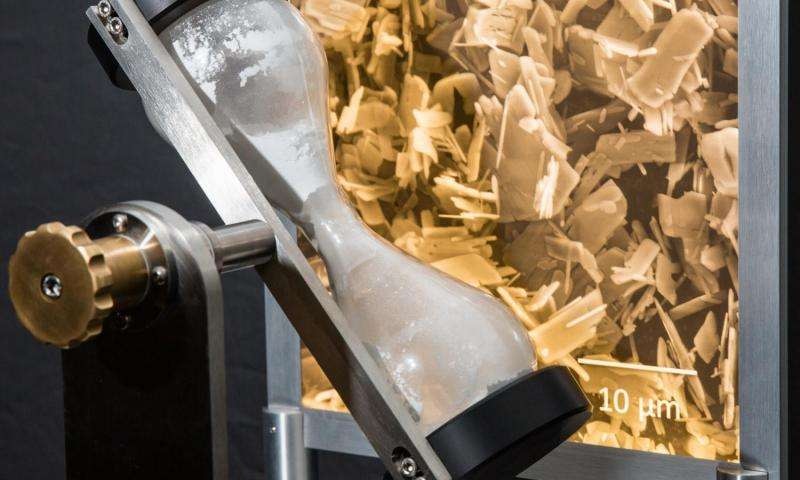Apr 13 2017
 Exhibit for flake like zinc-phosphate particles for better corrosion protection: Because of the disordered arrangement of the flakes, they cannot run through the sandglass like spheric particles do. (Credit: Ollmann)
Exhibit for flake like zinc-phosphate particles for better corrosion protection: Because of the disordered arrangement of the flakes, they cannot run through the sandglass like spheric particles do. (Credit: Ollmann)
In architecture, ship-building, and bridge construction, large quantities of steel are traditionally used. Such structures are meant to last for a long time and at the same they should not lose any of their qualities regarding safety and strength even after many years. Due to this reason, steel girders and plates that are used have to be durable and should provide excellent protection against corrosion. Oxygen in the air, salts, and water vapor are particularly known to corrode steel. Therefore, in order to prevent the corrosive substances from entering into the material, a standard approach is to develop an anti-corrosion coating by applying layers of paint of zinc-phosphate particles. Now, researchers at INM – Leibniz Institute have developed a unique type of zinc-phosphate particles that are 10 times as long as they are thick, and thus have flake-like shapes.
The researchers will be presenting their study results and the possibilities they provide at stand B46 in hall 2 at Hannover Messe which will be held from 24 to 28 April, 2017.
Initial experiments conducted with the new, flake-type zinc-phosphate particles indicate a better solubility when compared to spherical particles. This is due to the anisotropy of the zinc-phosphate particles.
“Now, more phosphate-ions are soluted and repassivation of bare metal surface, for example as a consequence of a mechanical damage, is better and faster,” the head of the program division Nanomers®, Carsten Becker-Willinger says.
In first test coatings, we were also able to demonstrate that the flake-type particles are deposited in layers on top of each other thus creating a wall-like structure. This means that the penetration of gas molecules through the protective coating is longer because they have to find their way through the ´cracks in the wall´.
Carsten Becker-Willinger, Head of Programs Division, Nanomers®
The outcome was that the corrosion process was considerably slower when compared to coatings with spheroid-shaped particles, where the gas molecules can easily penetrate the protective coating of the metal much more rapidly.
In more series of tests, the researchers successfully verified the effectiveness of the novel particles. To achieve this, they submerged the steel plates both in electrolyte solutions with flake-type shaped zinc-phosphate particles and with spheroid-shaped zinc-phosphate particles in each case. After a period of several hours, the steel plates in the electrolytes with flake-type particles were found to be in good condition, even after three days. On the other hand, the steel plates in the electrolytes with spheroid-shaped particles began to show signs of corrosion.
INM’s controlled precipitation process was used to synthesize the flake-type shaped zinc-phosphate particles.